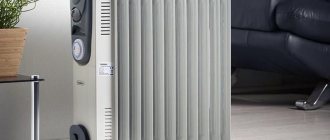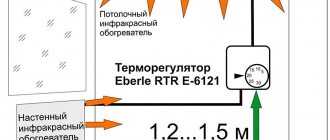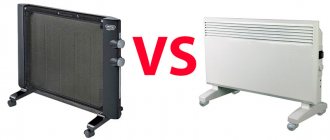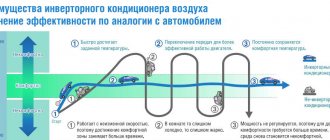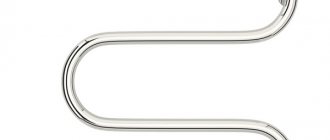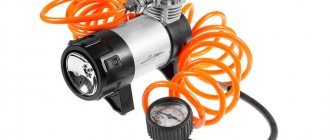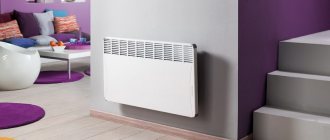The onset of cold weather forces apartment owners to think about ways to additionally heat their homes. One option is to buy a heater. They come in different heating methods, energy sources, and operating principles. In the material “Quartz Heaters,” the site’s editors examined in detail two types of devices that are based on quartz and have the adjective “quartz” in the name, but differ in design and method of heating the room. The volume of work did not allow for a comparative analysis between them.
Let's fill the gap and compare infrared and quartz heaters. At the same time, we clearly distinguish between the devices:
- Quartz heaters include monolithic panels made of pure quartz or with white clay additives (ceramic quartz);
- infrared heaters can be quartz, gas (halogen), diesel, etc. This work considers only quartz infrared devices. To eliminate a little confusion, we will simply call them “infrared heaters.”
Quartz heater
The definition of “quartz heater” includes many heating devices, including heat guns with built-in blocks of mineral elements that retain heat. But these are all tricks of marketers trying to exploit the popularity of classic quartz heating devices, which are a monolithic slab with a heating element built inside.
Structure
In a heating device, the heating element is hermetically sealed in a slab of pure quartz or a mixture with white clay (ceramic-quartz device). To do this, the raw materials are pressed and then sintered in an oven at high temperature. The result is a durable but fragile layer that performs several functions at once:
- prevents oxygen from reaching the heating element - there is no oxidation process during heating;
- accumulates heat like stones in a village bathhouse;
- transmits infrared radiation.
The back wall of the case is covered with a screen that reflects IR rays - the vast majority of manufacturers offer to buy it separately, not including it in the package. Between it and the panel in some models you can find a profiled heat exchanger. A number of manufacturers place the device in a metal case. In general, the design is simple, yet non-separable.
The disadvantage of this structure is the lack of a thermostat. Technologists deliberately do not install it - there is nowhere to mount it. In the case, it will react to the heat of the shell, and when removed at a sufficient distance from the stove, you need a set of a temperature sensor and a thermostat, which must be mounted on a permanent basis. And this is depriving the quartz battery of mobility.
Principle of operation
When operating a quartz heater, two principles of heat transfer are used: convector and wave. In the first case, the device works in the same way as a conventional central heating battery: it heats the air around it, which rises upward, giving way to colder air masses. According to the second method, infrared rays, having overcome the quartz shell, heat the floor, walls, furniture, i.e. everything material encountered on the path of the rays.
The operating algorithm of the device is as follows:
- after switching on, the heating element quickly becomes red-hot and begins to emit infrared rays;
- passing through the quartz shell, the waves give off some of the energy to it, causing the panel to heat up;
- all objects around begin to slowly heat up;
- in 20-30 minutes. the case temperature rises to +95oC (in some models a little higher than +85oC), after which heating starts using the convection method: cold air currents displace warm air. And so in a circle;
- the heated panel practically does not take energy from the wave radiation - IR heating begins to work at full power;
- the surface within the reach of infrared rays slowly warms up;
- heated objects themselves become sources of heat, in turn heating the air around them;
- After the panel is turned off, it cools down for a long time, maintaining a comfortable temperature in the room.
Specifications
Most quartz panels have the following characteristics:
- rated power - 0.4-0.8 kW;
- maximum power – 3.0 kW;
- weight - 12-14 kg;
- linear dimensions - 60x35x2.5 cm;
- cooling rate - 2oC per minute;
- the average efficiency of the device (not to be confused with the beautiful figure of the efficiency of electricity use, which is in the range of 98-99%) is 87-94% (this includes electricity losses from the resistance of the wiring inside the apartment and heating the ceiling);
- case temperature - about +95oC;
- The time it takes for the panel to warm up to the optimal level is 20-30 minutes.
What kind of heater is called quartz?
Until recently, no one had heard anything about devices with this name, but today they are in demand everywhere. It’s been a long time since there has been a replenishment in the niche of heating devices and, finally, we can say that a development worthy of users’ attention has appeared. So what exactly is the appeal of these wonderful devices?
Quartz heaters have many advantages. They are always in demand and can fit into the Smart Home concept, since they can be programmed and controlled remotely
The market offers users two types of quartz heaters:
- monolithic (MKTEN);
- infrared.
Let's talk about the characteristics and design of both.
Infrared heaters
An infrared heater, also called a reflector, is fundamentally different from a quartz device.
Structure
IR heaters are quartz flasks with a heating element (tungsten, nichrome wire or carbon strips) enclosed in a metal or plastic housing. The front side of the device is open to IR rays. On the reverse side, behind the tubes, a reflector is placed that redirects the radiation towards the room.
With successful focusing, the scattering angle of reflected waves is minimal, which increases the efficiency of the device. Brackets are screwed or soldered on the back wall, allowing you to hang the device on a wall or ceiling anywhere. The schematic diagram of the device can be seen below.
Principle of operation
Infrared heaters use the ability of quartz (SiO2 - silicon dioxide) to transmit electromagnetic waves in the IR radiation range. To do this, a heating element is placed inside the quartz tube, capable of emitting red-hot infrared waves of different lengths (the wavelength depends on the temperature of the spiral - the higher, the longer).
IR rays, meeting an obstacle (floor, furniture, walls, other objects, as well as a person) transfer their energy to it. The surface heats up, becoming in turn a source of heat for the surrounding air. As you can see, unlike central heating radiators and oil radiators, it is not the atmosphere of the room that is initially heated, but the hard surface.
The device works like this:
- after switching on, the spiral becomes red-hot and begins to emit IR rays;
- the surface of objects within the reach of IR radiation heats up;
- the surrounding air is heated from heated walls, floors, furniture and various objects;
- When the set temperature is reached in the room, the device automatically turns off;
- As the temperature drops, the electrical appliance turns on.
The operating principle of a quartz IR heater.
Specifications
The basic performance characteristics of the main models of IR heaters are as follows:
- operating power - 0.3-0.8 kW;
- maximum power - 3.0 kW;
- weight - 0.7-2.0 kg;
- average efficiency of the device is 87-95%;
- case temperature - no more than +70oC;
- cooling period - no.
Let's summarize the first results: the difference between a quartz heater and an infrared heater is in the structure of the device and the method of heating the room.
Quartz or infrared heater: Selecting a heater
Infrared heater
In general, all thermal heaters that use the transfer of thermal energy in their principle are infrared. This is explained by the fact that the heat of a stove, a boiler, the heat of a table heated by the sun - all these phenomena emit in the infrared spectrum. This diffraction distribution spectrum can only be seen with special glasses.
But there are also infrared heaters with direct radiation of the infrared spectrum, similar to ultraviolet rays. These devices have a very unique design and operating principle.
Advantages and disadvantages
The compared devices have common pros and cons (discussed in detail here). However, the different structures and operating principles revealed the individual strengths and weaknesses of the devices. This makes it possible, by comparing their advantages and disadvantages, to draw preliminary conclusions: which is better - a quartz or infrared heater.
Quartz heater
The quartz panel has many positive aspects:
- high efficiency - device efficiency is 75-95%;
- rapid heating of the panel - about 20 minutes, after which there is an intensive heating process;
- simple design - there is simply nothing to break;
- simple and quick installation on the floor or wall;
- large thermal capacity, allowing you to maintain a comfortable temperature in the room for a long time after switching off;
- high level of tightness, allowing the device to be used in rooms with high humidity;
- long service life - from 20 to 30 years;
- silent operation (when ceramics are added to the panel, crackling noise is sometimes heard when heating and cooling);
- Voltage fluctuations or short-term power outages do not affect the quality of heating - the panel that has accumulated heat saves the day;
- good design that allows the device to fit into the interior without problems;
- it is possible to connect various types of automation in the form of climate control or thermostat, which will significantly increase the efficiency of the quartz stove;
- ability to work from a smart socket - turned on and off by smartphone.
disadvantages :
- quite high price;
- the weight of the panel makes it difficult to transport and hang on the wall - not every panel can withstand such a load;
- The package does not include a thermostat (only a dozen out of several hundred models have it);
- increased electricity consumption, which does not coincide with the passport data (there, as a rule, power and electricity consumption are equalized, which does not correspond to real consumption due to natural losses);
- like all heaters, it dries the air, although manufacturers claim the opposite;
- fragility of the panel;
- If the heating element fails, the device cannot be repaired;
- high temperature of the surface of the case - you can get burned;
- budget options have an unattractive appearance and a short service life.
Infrared heater
advantages of quartz reflectors :
- affordable prices;
- rapid heating of rooms;
- high efficiency - 87-95% (the ceiling space is not heated);
- there are no convection currents that raise dust into the air;
- almost uniform heating of the room along the height. At the same time, the temperature in the floor area is always higher, which ideally fits the proverb “keep your head cold and your feet warm”;
- easy installation;
- light weight, allowing you to easily move the device from room to room or transport it to the dacha and back;
- long service life;
- maintainability - a burnt or damaged tube can be replaced;
- no maintenance required;
- You cannot get burned on the reflector body;
- compact dimensions allowing you to place the device on a windowsill;
- has the effect of a heat gun - allows you to quickly and evenly dry walls, clothes, a painted car, etc.;
- interesting design - can always be matched to a decorated interior;
- safe operation, including automatic shutdown when tipped over, a grille on the front side (prevents burns), no harmful fumes if the flask is damaged.
some disadvantages . What would it be like without them:
- long-wave radiation is harmful to humans. Therefore, the heating of the spiral should not exceed +300oC (maximum possible temperatures – +1200oC);
- prolonged exposure to direct rays on the human body causes unpleasant sensations. Therefore, the bed should not be in the direct radiation area;
Nice picture, but it shouldn't be like that.
- There is a thermostat built in, but this is pointless, because... greatly reduces the efficiency of the device - shutdowns do not exceed 10 minutes, and heating the coil requires additional electricity;
- rapid cooling of the room when the device is turned off;
- Red light at night has a negative impact on a person’s mental state—lethargy and apathy appear in the morning. A night light will help you avoid problems, but this will add additional energy costs.
Operating principle and selection criteria for a quartz infrared heater
Infrared heaters differ from other heating devices in that they can be used for spot, zone heating. This possibility is due to the specific operation of this equipment. Quartz infrared heater is one of the most popular devices that attracts consumer attention with its high efficiency.
What are quartz infrared heaters?
There are two types of quartz heaters on the heating equipment market:
- monolithic (MKTENs);
- infrared.
Despite the fact that both types of devices operate on the basis of quartz, their heating principle is different. MKTENs are slabs containing quartz sand. When heated, they transfer heat to the air, and it spreads throughout the room.
The stove takes a long time to heat up and cool down. This heating method was called the “brick effect”.
Infrared heats not the air, but objects with a hard and relatively hard surface. From them, heat spreads to the nearest space.
What is it for and where is it used?
The quartz infrared heater is suitable for general use. Devices of this type are most beneficial for creating a comfortable microclimate in rooms with insufficient quality insulation, in through-ventilated corridors, and in places with high traffic.
IR heaters are also installed in residential, public and industrial buildings.
Most common applications:
- shopping pavilions;
- country houses with seasonal accommodation;
- showcases;
- summer cafes;
- Living spaces;
- garages;
- offices.
How it works: device and principle of operation
They are called quartz devices because the emitter in them is a tube made of quartz glass. A thin spiral-shaped tungsten wire is used for heating. It is located inside glass tubes from which air has been removed.
Operating principle of a quartz heater:
- the tungsten spiral heats up and transfers heat to the glass;
- the tube on the back side is covered with a reflective layer, ensuring unidirectional propagation of IR rays;
- infrared radiation reaches various surfaces and begins to heat them;
- objects transfer heat to the space around them.
A significant drawback of devices of this type is the fragility of the emitter. The tubes heat up to high temperatures and can crack if exposed to moisture. Sudden temperature changes are also undesirable for these devices. Typically, the warranty for quartz IR heaters does not exceed 1.5 years. This technique requires careful and careful handling.
Mounting methods
The range of quartz infrared heaters includes floor, wall and ceiling models. Moreover, the last two categories are interchangeable. That is, if a manufacturer positions its device as wall-mounted, it can also serve as a ceiling-mounted one. The heaters are equipped with special mounting brackets.
Swivel brackets are required for installation in corners.
Ceiling fixtures are supplied with hangers. They are installed in special grooves in the body, after which they are put on hooks mounted on the ceiling.
All manufacturers indicate in the instructions the recommended minimum distance between the rear panel of the device and the ceiling/wall.
Wall-mounted models are installed on consoles and brackets. The mounting elements are attached to the wall, after which the device is fixed to them. Floor-standing devices can be installed on any flat horizontal surfaces.
Reviews of quartz infrared heaters: pros and cons
According to user reviews, quartz IR heaters have their disadvantages:
- since the glass tube is heated to high temperatures, the dust that falls on it burns and a specific odor is formed;
- Due to the relative fragility of the emitter, drops of water should not be allowed to get inside the housing.
But the devices have much more advantages:
- rapid heating of the room;
- high efficiency;
- the air is not dried because it is not heated;
- compactness;
- stylish design;
- modern models have many useful options that increase ease of use.
Open infrared emitters or monolithic panels?
Due to the high heating rate, quartz heaters are often purchased for use in cottages and garages during the cold season. Moreover, infrared ones in this regard are much more effective than quartz monolithic ones. But the latter are more profitable because they give off heat for a long time. And when you turn off the infrared, objects heated by it quickly cool down.
The following conclusions can be drawn:
- monolithic panels are beneficial due to their high heat capacity;
- infrared - heating rate.
In accordance with this, the device that is most effective for specific situations is selected. For short-term visits to cold rooms, IR heaters are more profitable; for long-term stays, you can use quartz panels.
Manufacturers and popular models: ranking of the best and prices
The vast majority of heating equipment manufacturers also offer quartz IR heaters. These are NOIROT, EWT, Stiebel Eltron, AEG, “Comfort”. The range of these companies includes devices that have proven themselves to be the best in this category of climate control equipment.
Noirot Royat 2 1200
The heater is equipped with a waterproof housing and is recommended for use in rooms with high humidity, on terraces, in gazebos, on balconies and loggias. Has electrical safety class II. There is a power switch on the top panel. The model is designed for wall mounting and can serve areas up to 15 m2.
Specifications:
- three power levels - 300/600/1200 W;
- geometric parameters - 120x110x450 mm;
- weight - 1.3 kg.
Average price 6840 rub.
IR heater EWT Strato IR 106 S
Device for spot heating of premises. Wall mounting, horizontal. The body is made of anodized aluminum, coated with heat-resistant powder paint. The heater has a protection class of IP24, which allows it to be installed in open spaces and with high humidity levels.
Specifications:
- power - 500 W;
- geometric parameters - 760x90x110 mm;
- weight - 1.1 kg.
Average price 2450 rub.
Stiebel Eltron IW 180
One of the best quartz infrared heaters for the home. The device is wall-mounted and equipped with a console that allows you to adjust the angle of inclination and rotation. The case is metal, silver color. The heater has three operating modes.
The power is regulated via a dense cord mounted on the bottom panel. The high degree of moisture protection of the case allows you to install the device outdoors and in bathrooms. There is an indication of inclusion. Country of origin: Germany.
Specifications:
- three power levels - 600/1200/1800 W;
- geometric parameters - 145x535x85 mm;
- weight - 1.55 kg.
Average price 6000 rub.
Compact heater AEG IWQ 120
Small-sized heater for wall installation. Equipped with a cord for mechanical switching of heating intensity. The kit includes a swivel bracket. The device is characterized by a quick start to operating mode: maximum power is achieved within 30 seconds.
Specifications:
- two power levels - 600/1200 W;
- geometric parameters - 100x610x175 mm;
- weight - 1.2 kg.
Average price 2700 rub.
Engy PH-1500С
The heater is wall-mounted, the body is made of heat-resistant plastic. The device is equipped with overheating protection and is capable of heating rooms up to 20 m2. It features economical energy consumption.
Specifications:
- power - 1500 W;
- geometric parameters - 920x143x235 mm;
- weight - 3.2 kg.
Average price 2649 rub.
Tabletop quartz heater SUPRA QH-817
One of the most compact tabletop quartz heaters. On the rear panel there are toggle switches for turning the device on and off and switching its power. The model has a stylish design. The case is shockproof and made of white plastic.
Specifications:
- power - 800 W;
- geometric parameters - 245x345x140 mm;
- weight - 1.27 kg.
Average price 599 rub.
Comfort K-19H
Floor-standing heater, metal body painted with powder paint. The stability of the device is ensured by two legs. The heater is equipped with 4 heating elements and is highly efficient. The built-in fan ensures even heat distribution.
Specifications:
- power - 2000 W;
- mechanical control;
- adjustable thermostat.
Average price 1610 rub.
Which manufacturer and which type is better to choose: TOP-3
The products of the manufacturers NOIROT, EWT, Stiebel Eltron, AEG, and “Comfort” deserve attention.
Calculation of the minimum required power
To use IR heaters in residential, well-insulated rooms, use a simple power calculation scheme: 100 W per 1 m2.
For poorly insulated and non-insulated buildings, more efficient devices are needed, based on the calculation of 200 W per 1 m2.
What else to consider when choosing a device?
When choosing an IR heater, take into account its dimensions and design. Pay attention to the presence of power modes that allow you to adjust the degree of heating. Since the devices operate silently, an option such as a light indicator for switching on is useful.
3 best models
Among the range of quartz infrared heaters, the best are:
- Noirot Royat 2 1200;
- Stiebel Eltron IW 180;
- Engy PH-1500C.
These devices have several performance levels, are easy to use, and have proven themselves to be reliable and durable.
Price
The price of heaters primarily depends on their power, the availability of heating intensity modes and additional options.
Average price of the best models:
- Noirot Royat 2 1200 - 6840 rub;
- EWT Strato IR 106 S — 2450 RUR;
- Stiebel Eltron IW 180 - 6000 rubles;
- AEG IWQ 120 - 2700 rub;
- Engy PH-1500С — 2649 RUR;
- SUPRA QH-817 — 599 RUR;
- Comfort K-19H — 1610 rub.
Where to buy a quartz infrared heater?
In Moscow
- DNS online store, 8-800-77-07-999.
- Online store "Yulmart".
- Online store "Regard".
In St. Petersburg
- Online store "Regard".
- Online store SIDEX, 8 (812) 389-30-5
- Online store "Citylink".
Quartz infrared heaters are in great demand among summer residents and owners of unheated garages. Equipment of this type is distinguished by its compactness, silent operation and affordable price.
Apr 9, 2018ventsyst
Performance Comparison
Listing the advantages and disadvantages of the compared heaters gives a general impression of the devices. But it is impossible to understand how a quartz heater differs from an infrared heater in terms of efficiency, safety, cost, service life, and other criteria. Therefore, we will conduct a comparative analysis of the main operational indicators:
- cost;
- energy efficiency;
- efficiency of the device;
- service life;
- general security;
- fire safety;
- environmental cleanliness;
- room heating speed;
- cooling time;
- mobility;
- location;
- Areas of use;
- maintainability;
- design;
- strength.
Which is cheaper?
Prices for good quality infrared heaters start from 700 rubles. Monolithic panels cost about 3 times more - you can buy them for 2,500-24,800 rubles, while one of the most powerful IR heaters “Ballu” BIH-L-3.0 costs about 4.0 thousand rubles.
Conclusion: for limited budgets, the ideal option is to buy a reflector.
Energy efficiency
When the coil is heated, electricity is converted into electromagnetic radiation. The main part falls on the IR spectrum. In a monolithic panel, a magnetic field is additionally induced (approximately 1-2% of energy is spent). Therefore, the efficiency of quartz heaters is about 98%. The same processes occur in the reflector, but additional waves of visible light are emitted. Therefore, energy efficiency here is lower - 94-95%.
Conclusion: all things being equal, the energy consumption of reflectors is higher.
Heater efficiency
The heat generated by devices is used in different ways. With an IR heater, almost all of it goes to heating the usable area of the room. The quartz panel spends some of the heat to heat the ceiling space. The diagram below clearly shows the difference between heaters, where under the convection method the operation of the panels is shown, and the infrared method shows the operation of reflectors.
Scheme of convective and infrared heating of a room.
However, one should take into account such a nuance as the temperature of objects, floors and walls. It is higher during wave heating, taking away some of the heat.
Conclusion: the efficiency of the panel is lower, but the difference is small.
Durability
According to theory, devices should have the same service life. Practice has shown that reflectors last less, which is illogical - burnt-out heating elements can be replaced, extending the life of the device.
Conclusion: the service life of heaters is influenced by many factors. No one has an advantage if you treat your devices with care. But it makes no sense to take operating conditions into account - there are many of them.
Safety
The hot panel burns if touched accidentally. Therefore, if you have small children or animals in the house, you need a protective screen. The reflector does not have this problem - the body heats up slightly, and the bulbs are protected by a screen.
If we take the protection against electric shock, then it is the same, with a small exception - the panels can give you an electric shock when you first turn it on, which actually doesn’t hurt, just unexpectedly. The reason is poor drying of the heater. After calcination, the problem disappears.
Conclusion: in terms of overall safety, the devices are equal.
Fire safety
At a temperature of +95oC, no material will ignite. Therefore, the probability of fire in quartz devices is zero. There is a risk of fire from the IR device, but it is minimal. Here the danger is posed by a coil heated above +200oC. Manufacturers took this point into account and built into the device an automatic shutdown when tipped over.
The conclusions are also confirmed by practice - isolated cases of fire from reflectors are recorded, but under an absurd set of circumstances.
Conclusion: in terms of fire safety, quartz batteries have a slight advantage.
Ecological cleanliness
Quartz panels do not have anything that would negatively affect the human condition. It's a little different for infrared devices. There are a few points here.
- Long and medium waves of infrared radiation negatively affect humans. For domestic use, short-wave heaters are needed.
- Prolonged exposure to radiation for several hours in a row causes lethargy and apathy.
- On open areas of the body, the skin may “cook” (details can be found here).
Conclusion: you need to be careful when using IR heaters.
Room heating speed
To achieve a comfortable temperature in the room, a quartz device needs time - several hours. It only takes a dozen minutes for his opponent to feel the heat.
Conclusion: the reflector will quickly warm up the room.
Cooling speed
Quartz panels can maintain a comfortable temperature for up to half an hour. When the reflector is turned off, the owners leave the comfort zone after about 5 minutes.
Conclusion: according to the characteristics under consideration, quartz batteries have an undoubted advantage.
Mobility
The mobility criterion depends on the weight and size of the device. Here, compact and lightweight infrared heaters have an undoubted advantage - even a teenager can carry them from room to room.
Conclusion: in terms of mobility, the quartz panel lags far behind its competitor.
Location
One of the key advantages of infrared heaters over their opponents is the ability to mount them on the ceiling. Such a resource of an electrical appliance allows you to solve many problems in a cramped room.
Conclusion: the quartz panel loses in terms of location.
Application area
The main advantages of IR devices include the ability to work in open or semi-enclosed areas (balcony, terrace, loggia, gazebo) while panels can only heat enclosed spaces.
Conclusion: according to the indicated criterion, quartz heaters lose significantly.
Maintainability
It is not possible to restore a panel that has stopped working - it is not dismountable. You can replace any element of the reflector yourself. The main thing is to have something to change for. Therefore, you need to buy those models for which quartz tubes are available for sale.
Conclusion: the reflector is in the lead with a huge advantage.
Design
Quartz panels, with the exception of a few models, look less presentable compared to their competitors, although, judging by the reviews on the forums, there are those who, in principle, do not accept the reflector
Conclusion: the reflector has an advantage in design.
Strength
If dropped, the tube will crumble and the panel will crack. In the first case, the heating element can be replaced, in the second, the heater will work, but its service life will be reduced due to the new access to the oxygen coil.
Conclusion: both heaters are fragile, but the panel still has the advantage - it will continue to work.
The reason for the popularity of infrared models
Most often, these heaters are placed on the ceiling or at a significant location. They are in high demand and there are several reasons for this:
- These are fairly lightweight models that do not take up much space in the house.
- Installing such a device is easy, even alone.
- This device is adjustable.
- The infrared model is considered the most fireproof today.
- The efficiency of these most efficient devices is close to 95%.
When they are turned on, the radiation spreads almost instantly. It gets warm just as quickly. The operating speed of an infrared heater is higher than that of an oil radiator, fan heater and microthermal devices. Another advantage is that it can fit perfectly into the Smart Home concept, since it can be controlled remotely from the owner’s smartphone or via the Internet, or work according to a given program.
This diagram of the Pion infrared heater clearly shows what elements this device consists of. This model, suspended from the ceiling, will effectively heat a fairly large room.
